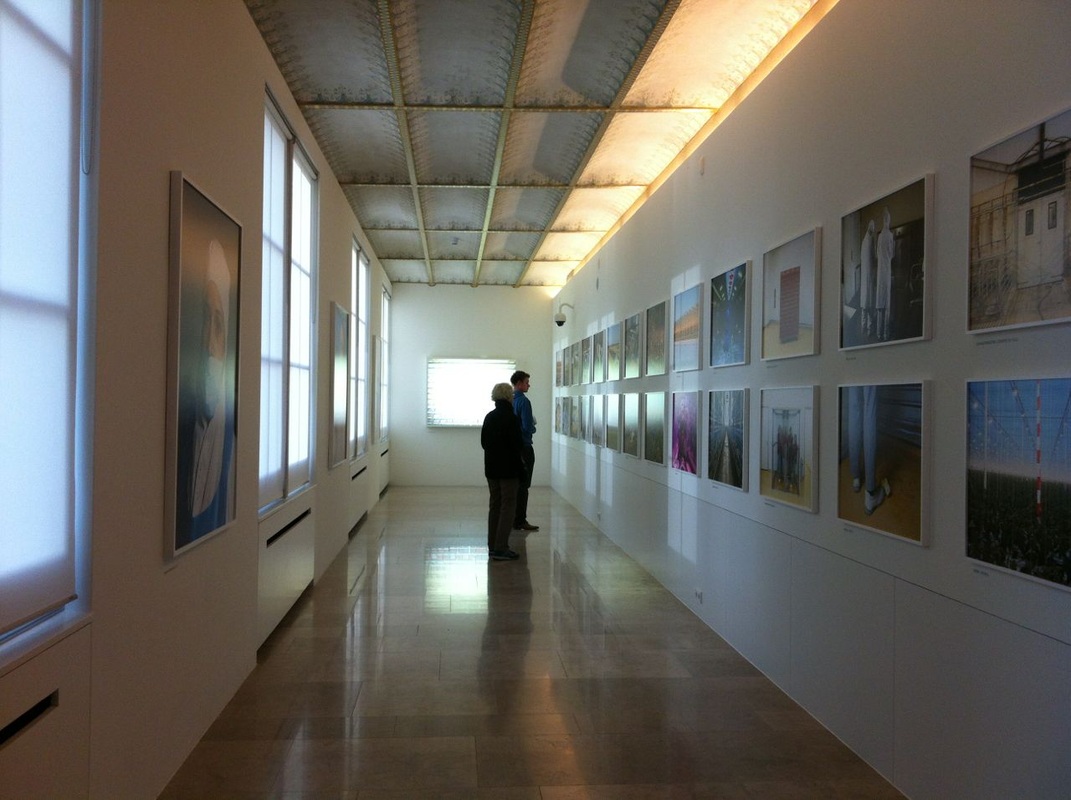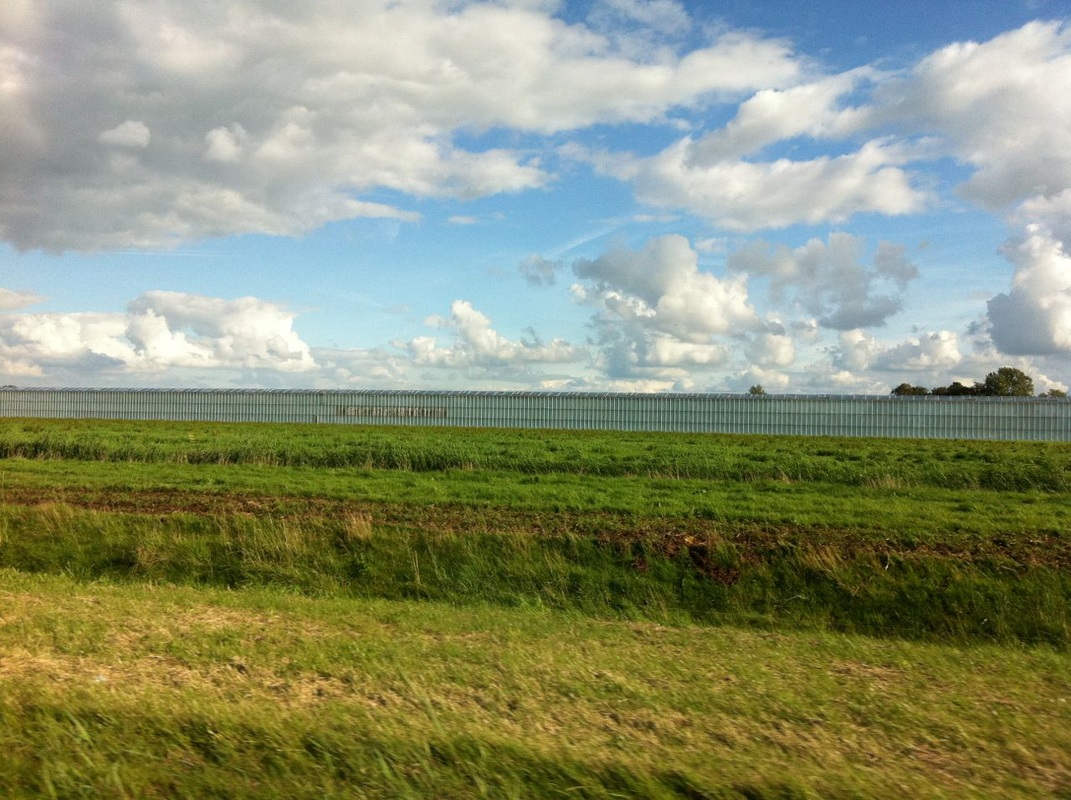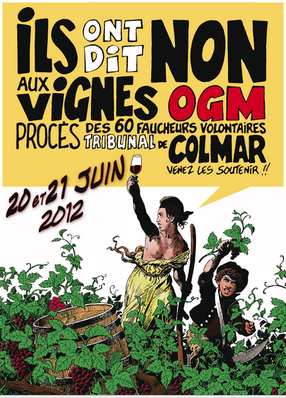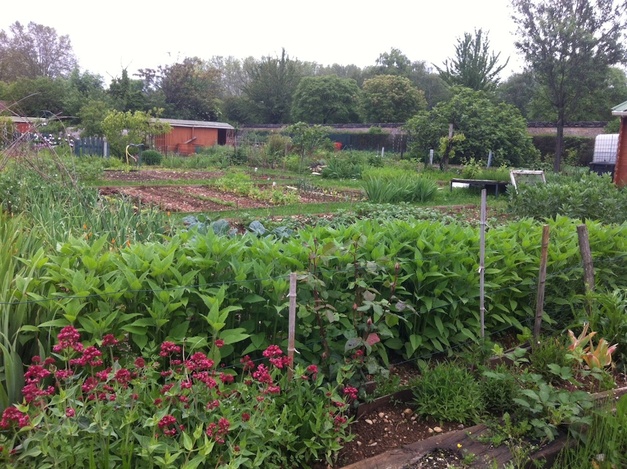This blog has taken a holiday of several months for the birth of my son! Inspired in part by that experience, I was thinking of writing next about healthcare systems in France and the US and their relationship to agriculture, but I think I'll save that for later.
Today I want to write about an exhibition I saw on a recent trip to Amsterdam, by the Dutch photographer Henk Wildschut. Wildschut's work on food was commissioned by the Rijksmuseum and NRC Handelsblad, a Dutch daily newspaper, as part of an annual initiative known as Document Nederland. The resulting exhibition is titled Document Nederland: Ons dagelijks brood (Documenting the Netherlands: Our Daily Bread) and is on display at the newly renovated (and spectacular!) Rijksmuseum until early January.
The exhibition (see photo below) only shows a fraction of Wildschut's photographs for the project. More are included in the accompanying book, titled "Food" in the English version, which also features an index with short descriptions of the locations, enterprises and activities represented. The Netherlands claims to be the second-largest agricultural exporter in the world, after the US, but it must be neck and neck for that position since you often hear the same claim made for France. In any case, that level of productivity for Dutch agriculture is breathtaking given its tiny geographic area (about one fifteenth the size of France). According to the Dutch Ministry of Economic Affairs, Dutch agricultural exports totalled €75.4 billion in 2012.
Today I want to write about an exhibition I saw on a recent trip to Amsterdam, by the Dutch photographer Henk Wildschut. Wildschut's work on food was commissioned by the Rijksmuseum and NRC Handelsblad, a Dutch daily newspaper, as part of an annual initiative known as Document Nederland. The resulting exhibition is titled Document Nederland: Ons dagelijks brood (Documenting the Netherlands: Our Daily Bread) and is on display at the newly renovated (and spectacular!) Rijksmuseum until early January.
The exhibition (see photo below) only shows a fraction of Wildschut's photographs for the project. More are included in the accompanying book, titled "Food" in the English version, which also features an index with short descriptions of the locations, enterprises and activities represented. The Netherlands claims to be the second-largest agricultural exporter in the world, after the US, but it must be neck and neck for that position since you often hear the same claim made for France. In any case, that level of productivity for Dutch agriculture is breathtaking given its tiny geographic area (about one fifteenth the size of France). According to the Dutch Ministry of Economic Affairs, Dutch agricultural exports totalled €75.4 billion in 2012.
"Documenting the Netherlands: Our Daily Bread" exhibit at the Rijksmuseum, Amsterdam (my photo).
As those figures suggest, the Dutch agricultural sector is known for its intensity and sophistication. As in so many places, Dutch agriculture has been consolidating dramatically in recent decades, with the number of farms and farm businesses falling and those that remain increasing in both size and output. The sector prides itself on recent environmental gains, however: an OECD study reported dramatic reductions in excess nitrogen and phosphorous, for example. Other innovations involve the use of waste heat for the nation's extensive area of greenhouse production. Indeed, the Netherlands have something like 10,000 hectares of greenhouses, and what strikes you as you move through the landscape is how little of Dutch agriculture is visible to the outsider--which is to say, how little of it takes place outdoors.
That's what's so compelling about Henk Wildschut's documentary project--most of his pictures are taken indoors: in greenhouses growing tomatoes and peppers, in potato-processing plants, in slaughterhouses, in hatcheries and genetics research facilities. In many ways Wildschut's work reminds me of the 2005 documentary film Our Daily Bread, by Austrian director Nikolaus Geyrhalter--it has the same focus on large-scale agricultural production, on standardisation and automation, and on what automation does to animals and to human workers. Geyrhalter's film had no voice-over, no dialogue, and no identifying captions, just the ambient noise of the machines and sometimes the murmuring of the workers in the background, but the overall message was clear: a kind of horror at what our agricultural system has become, how scale and repetition can dehumanise food production.
Wildschut provides a bit more context with his descriptions, and at first glance the message appears to be a similar one: vast antiseptic interior environments with concrete floors, stainless steel machinery, and workers isolated in their protective clothing; uniform tomato plants under glass as far as the eye can see; conveyor belts transporting newly hatched chicks to be de-beaked and then placed in the cages where they will grow into meat. Interestingly, however, Wildschut includes a statement in which he says that he came out of the project with fewer fixed ideas than he had when he began:
That's what's so compelling about Henk Wildschut's documentary project--most of his pictures are taken indoors: in greenhouses growing tomatoes and peppers, in potato-processing plants, in slaughterhouses, in hatcheries and genetics research facilities. In many ways Wildschut's work reminds me of the 2005 documentary film Our Daily Bread, by Austrian director Nikolaus Geyrhalter--it has the same focus on large-scale agricultural production, on standardisation and automation, and on what automation does to animals and to human workers. Geyrhalter's film had no voice-over, no dialogue, and no identifying captions, just the ambient noise of the machines and sometimes the murmuring of the workers in the background, but the overall message was clear: a kind of horror at what our agricultural system has become, how scale and repetition can dehumanise food production.
Wildschut provides a bit more context with his descriptions, and at first glance the message appears to be a similar one: vast antiseptic interior environments with concrete floors, stainless steel machinery, and workers isolated in their protective clothing; uniform tomato plants under glass as far as the eye can see; conveyor belts transporting newly hatched chicks to be de-beaked and then placed in the cages where they will grow into meat. Interestingly, however, Wildschut includes a statement in which he says that he came out of the project with fewer fixed ideas than he had when he began:
My research focused especially on farmers and entrepreneurs who were looking for innovation.... I soon discovered that economic pressures and legislation relating to public health, the environment and animal welfare largely dictate the way many cutting-edge entrepreneurs work. To survive they are forced to cross over from traditional production processes to industrial methods where efficiency and scaling-up are all-important. This is just as true of organic production.... Increasingly... our food is created in a clean world of rules and protocols.
So Wildschut's point is subtler, or at least more clearly articulated: automation and industrialisation are causing agriculture to lose its human scale, but equally important is the fact that agriculture has moved indoors, and it has done so for a variety of reasons, not least of which is disease control. This is an issue that affects organic producers as well as conventional ones: there are plenty of organic producers out there, for example,both large and small, moving into high tunnel production in part because it creates a more controlled environment and can thus reduce disease pressure. Indeed a basic principle of organic pest management is to rely on hygiene and sanitation instead of chemical pesticides. Similarly, I've spoken with organic pig producers in Iowa who talk about their need to isolate themselves from big conventional hog facilities that are "sinks for pig diseases". It's a landscape-scale issue, with everyone trying to isolate themselves from everyone else. (Wildschut's description of Dutch "designated agricultural development areas", known as LOGs and intended precisely to make it easier to prevent and control disease outbreaks, is fascinating in this regard.)
But what does this mean for someone like me, who has always been interested in agriculture in part because of its role as a creator and shaper of landscapes? How do the aesthetics of agricultural landscapes relate to our understanding of agricultural systems? The Dutch of course have a long-standing and important heritage of landscape painting, including agricultural landscapes, as you have only to go elsewhere in the Rijksmuseum to appreciate. Looking more closely at Wildschut's photographs, you realise that only a small handful have a visible sky, and often it's a sky glimpsed through a screen or distorting glass, as though he is purposely frustrating our impulse to think of farming as something that takes place outside, that involves wind and sun and fresh air. Wildschut calls this "a consumer-driven romanticized ideal". You have to wonder too what this trend will do in the long run to farming as a profession, given the frequency with which farmers speak of working outdoors as a major factor in their choice of career.
But what does this mean for someone like me, who has always been interested in agriculture in part because of its role as a creator and shaper of landscapes? How do the aesthetics of agricultural landscapes relate to our understanding of agricultural systems? The Dutch of course have a long-standing and important heritage of landscape painting, including agricultural landscapes, as you have only to go elsewhere in the Rijksmuseum to appreciate. Looking more closely at Wildschut's photographs, you realise that only a small handful have a visible sky, and often it's a sky glimpsed through a screen or distorting glass, as though he is purposely frustrating our impulse to think of farming as something that takes place outside, that involves wind and sun and fresh air. Wildschut calls this "a consumer-driven romanticized ideal". You have to wonder too what this trend will do in the long run to farming as a profession, given the frequency with which farmers speak of working outdoors as a major factor in their choice of career.
Greenhouses in the Dutch landscape (my photo).
In the meantime, however, this issue of visibility presents a major public-relations dilemma for the agricultural sector--or maybe it's better to say a major public-information dilemma for consumers. As Wildschut observes, farmers and farm businesses may not be hidden away indoors because they're specifically seeking to hide how they operate, but the effect is the same. The days when you could drive or take a train or even cycle through the countryside and learn a few things about the local agricultural scene seem to be disappearing.




 RSS Feed
RSS Feed